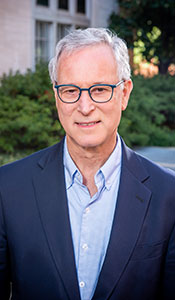Highlights of CDMRP Meetings
At the beginning of March, I spent a day in Washington, DC, meeting with congressional legislative aids to discuss the importance of continued NF research funding for the Congressionally Directed Medical Research Programs (CDMRP). The CDMRP was established in 1992 to support novel approaches in biomedical research to benefit the American public and the military. The program is funded by the Department of Defense (DoD) through the annual Defense Appropriations Act. However, funds for the program are not included in the DoD’s annual budget and must instead be renewed each year during the congressional budget approval cycle based on response to requests by consumer advocates and those affected by the condition. Our primary purpose in meeting with congressional aids was to explain the relevance and impact of NF research and the need for a continued investment that will lead to breakthrough treatments and improvements in patient care.
In addition to neurofibromatosis research, a wide range of biomedical research projects are funded by the CDMRP, including breast and ovarian cancer, autism, multiple sclerosis, and spinal cord injury, to name only a few. We emphasized during our meetings that NF research has implications for bone and wound healing, medical issues important to the military. Also, we discussed the fact that NF genetics research is yielding information that is applicable to several other areas of medicine. For example, it has been established that the NF1 gene is one of the most commonly altered genes in cancer. Some may wonder if these research projects could be funded through the National Institutes of Health (NIH), the nation’s largest government-funded medical research agency. While the NIH does fund important basic and translational research relevant to NF, it’s difficult for the NIH to direct funding to a specific condition, as the CDMRP has the flexibility to do. In fact, a hallmark of the CDMRP is filling critical research gaps by funding high-impact projects that would be not be feasible for other agencies. For example, the NF Clinical Trials Consortium – funded by a grant that integrates research at more than 17 sites coordinated by UAB – was developed 10 years ago in response to a funding need identified by the CDMRP for NF-related clinical trials. In this way, the CDMRP complements the work of the NIH by filling a critical niche. We found the congressional aids with whom we met to be supportive of continued NF funding for the CDMRP primarily because the program has a substantial return on investment. It also has the unique capability to leverage funds for high-impact research that might not otherwise receive needed support.
NF Neck Examination
Continuing our discussion about what to expect during an NF exam, I’d like to discuss issues that may be identified during a neck examination. The most common feature we look for on the neck is neurofibromas, benign nerve sheath tumors that appear on or under the skin. In children, neurofibromas can be sometimes difficult to distinguish from lymph nodes, which can usually be palpated in the neck; however, an experienced NF clinician can usually make this distinction.
Plexiform neurofibromas, which involve large branches of multiple nerves, can cause significant problems in the neck. In some people, they grow aggressively and can compress the airway and other structures in the neck. While it is possible for plexiform neurofibromas to encase the carotid artery and jugular vein, usually the blood flow is unimpaired.
Another problem associated with plexiform neurofibromas in the neck is possible compression of the spinal nerves as they exit the spinal cord, causing pain or weakness in one or both arms. For this reason, an NF exam should include monitoring of patients for pain and neurologic function in the arms. It’s also possible for plexiform neurofibromas to grow into the vertebral foramen, the gap between vertebral bones where nerve roots connect to the spinal cord. Surgical removal is the only treatment option for plexiform neurofibromas, which can be difficult in the neck due to the risk of damage to vessels and nerves that could cause serious bleeding and other problems. Because of these significant risks, we reserve surgery for critical cases in which important structures in the neck are affected.
Some people with NF develop narrowing of the major arteries, which commonly occurs in one or both kidneys. The reduced blood flow caused by the narrowing signals the kidneys to release hormones that result in high blood pressure, which is a significant health risk. During each NF exam, blood pressure is closely monitored to ensure this problem isn’t developing. Narrowing can also occur in one or both of the carotid arteries, the major arteries in the neck supplying blood flow to the brain. As this condition gradually develops, collateral blood vessels are formed to compensate for reduced blood flow to the brain. Although most people with carotid artery narrowing don’t experience significant symptoms, certain conditions, such as dehydration, significantly increase the risk of stroke in these individuals. We don’t routinely perform imaging tests to screen for this issue, although we’re alert to any symptoms a patient may be experiencing that could indicate this problem. When this problem is recognized we usually recommend starting a mild blood thinner, typically baby aspirin. In symptomatic cases, there are surgical approaches that can restore blood flow to the brain.
Director's Blog
Re-Cap of Meetings in Washington, DC, for Renewed NF Research Funding and a Review of What to Expect During an NF Neck Exam
- Details
- Written by: Bruce Korf
